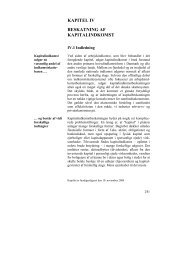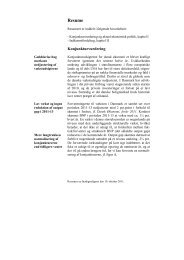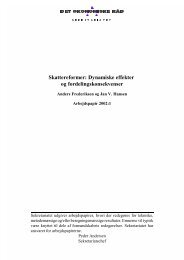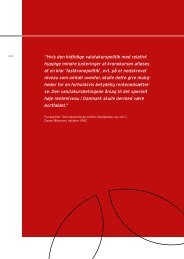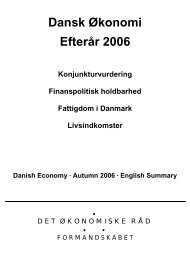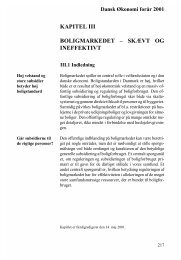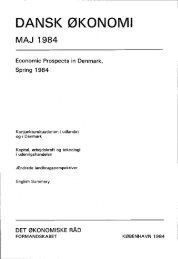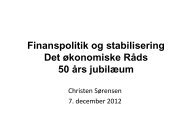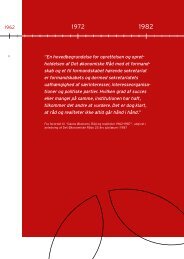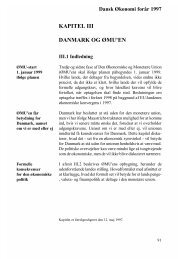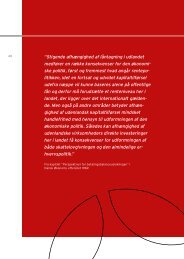The Effect of Learning and Fatigue on Preferences and WTP in a ...
The Effect of Learning and Fatigue on Preferences and WTP in a ...
The Effect of Learning and Fatigue on Preferences and WTP in a ...
You also want an ePaper? Increase the reach of your titles
YUMPU automatically turns print PDFs into web optimized ePapers that Google loves.
Note: ASC is the alternative specific c<strong>on</strong>stant for the status quo alternative. LL refers to the f<strong>in</strong>al log-likelihood <str<strong>on</strong>g>and</str<strong>on</strong>g> adj.<br />
Rho-square refers to the adjusted Likelihood Ratio Index. Because the discrete variables are effect coded, the n<strong>on</strong>-price<br />
attribute-coefficients have been multiplied by two, to account for the fact that the reference level is assigned a value <str<strong>on</strong>g>of</str<strong>on</strong>g><br />
-1 <strong>in</strong>stead <str<strong>on</strong>g>of</str<strong>on</strong>g> 0 (Bech & Gyrd-Hansen 2005).<br />
a <str<strong>on</strong>g>The</str<strong>on</strong>g> t-value for the scale factor is a t-value tested aga<strong>in</strong>st the null hypothesis H 0 : σ =1.<br />
Almost all attribute variables show a statistical significant effect <strong>on</strong> the choice probabilities, with<br />
the excepti<strong>on</strong> <str<strong>on</strong>g>of</str<strong>on</strong>g> the ASC <strong>in</strong> model (i) <str<strong>on</strong>g>and</str<strong>on</strong>g> the st<str<strong>on</strong>g>and</str<strong>on</strong>g>ard deviati<strong>on</strong> <str<strong>on</strong>g>of</str<strong>on</strong>g> the Campylobacter-free label <strong>in</strong><br />
models (i) <str<strong>on</strong>g>and</str<strong>on</strong>g> (ii). With adjusted rho-square values <str<strong>on</strong>g>of</str<strong>on</strong>g> above 0.256, all models describe the<br />
variati<strong>on</strong> <strong>in</strong> the data very well (Domencich & McFadden 1975; Louviere et al. 2000). It is however<br />
clear from the adjusted rho-square measures that the models based <strong>on</strong> all 16 CS perform much<br />
better than the models based <strong>on</strong> <strong>on</strong>ly 8 CS. Interest<strong>in</strong>gly, Model (ii) obta<strong>in</strong>s a markedly higher<br />
adjusted rho-square than Model (i). <str<strong>on</strong>g>The</str<strong>on</strong>g> fact that the model based <strong>on</strong> the last 8 CS obta<strong>in</strong>s a higher<br />
degree <str<strong>on</strong>g>of</str<strong>on</strong>g> estimati<strong>on</strong> precisi<strong>on</strong> than the model based <strong>on</strong> the first 8 CS provides a first <strong>in</strong>dicati<strong>on</strong> <str<strong>on</strong>g>of</str<strong>on</strong>g><br />
learn<strong>in</strong>g effects tak<strong>in</strong>g place.<br />
<str<strong>on</strong>g>The</str<strong>on</strong>g> effect <str<strong>on</strong>g>of</str<strong>on</strong>g> repeat<strong>in</strong>g the choice set sequence is <strong>in</strong>itially exam<strong>in</strong>ed through a likelihood ratio test<br />
for equality <str<strong>on</strong>g>of</str<strong>on</strong>g> model parameters (Louviere & Swait 1993). <str<strong>on</strong>g>The</str<strong>on</strong>g> test results are displayed <strong>in</strong> table 3.<br />
<str<strong>on</strong>g>The</str<strong>on</strong>g> null hypothesis is that scale adjusted parameters are stable across the first 8 CS <str<strong>on</strong>g>and</str<strong>on</strong>g> the last 8<br />
CS. First we look at the two models based <strong>on</strong> the first 8 CS <str<strong>on</strong>g>and</str<strong>on</strong>g> the last 8 CS, <str<strong>on</strong>g>and</str<strong>on</strong>g> a pooled model,<br />
which is not corrected for the scal<strong>in</strong>g effect. <str<strong>on</strong>g>The</str<strong>on</strong>g> test returns a test value at 1290, which clearly<br />
suggests that the hypothesis <str<strong>on</strong>g>of</str<strong>on</strong>g> equal parameters <strong>in</strong> the two models can be rejected at the st<str<strong>on</strong>g>and</str<strong>on</strong>g>ard<br />
5% level <str<strong>on</strong>g>of</str<strong>on</strong>g> statistical significance. <str<strong>on</strong>g>The</str<strong>on</strong>g> differences <strong>in</strong> parameter values between the two models<br />
might be caused by differences <strong>in</strong> the underly<strong>in</strong>g scale <str<strong>on</strong>g>of</str<strong>on</strong>g> utility <str<strong>on</strong>g>and</str<strong>on</strong>g> not due to differ<strong>in</strong>g preference<br />
structures (Swait & Louviere 1993, Tra<strong>in</strong> 2003). Thus, we estimate a pooled model account<strong>in</strong>g for<br />
different scales <str<strong>on</strong>g>of</str<strong>on</strong>g> utility across the two models <str<strong>on</strong>g>and</str<strong>on</strong>g> run the test aga<strong>in</strong>.<br />
13



